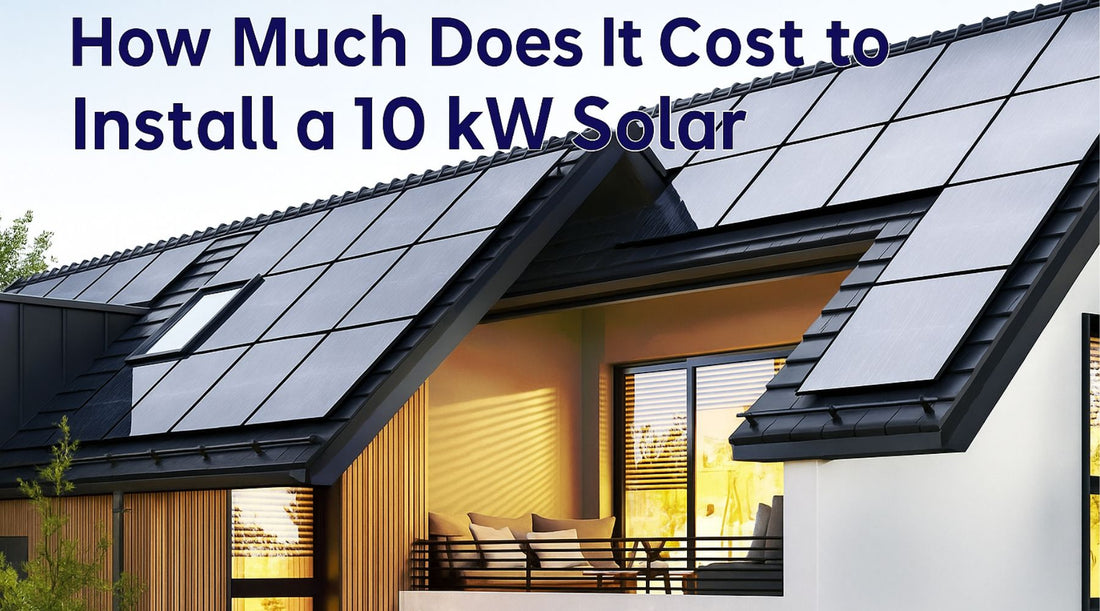
How Much Does It Cost to Install a 10 kW Solar System in 2025? (Portland & U.S. Guide)
Share
How much does it cost to install a 10kW solar system?
Installing a 10 kW solar Panel system is a big decision — it involves upfront costs, local regulations, equipment choice, incentives, and long-term returns. In 2025, the U.S. solar market is shifting rapidly (especially because of incentive changes). This article gives a friendly yet data-driven breakdown for both homeowners and solar installers, with special reference to the Portland / Oregon context. We’ll also weave in how Portlandia Electric Supply (PES) can support solar professionals in procurement and logistics.
Why 10 kW? Is It a Good Benchmark?
-
Many U.S. homes aiming to cover a substantial portion of their electricity use go for 8–12 kW systems.
-
A 10 kW system is often considered a “sweet spot” — big enough to deliver meaningful energy but not so large that costs escalate disproportionately.
-
For solar installers, 10 kW is a common commercial-utility-scale, residential quote size — good for showcasing to clients.
Because of economies of scale, the per-watt cost for a 10 kW system tends to be lower than for smaller systems.
Current U.S. Market Pricing (2025) — What You Can Expect
Here are some recent benchmarks:
-
The average U.S. cost per watt for solar installations in 2025 is around $2.66/W
-
That implies a base cost of around $26,600 before incentives for a 10 kW system.
-
After applying the 30% federal tax credit (ITC / Residential Clean Energy Credit), the net cost drops to roughly $18,620
-
Another source estimates a 10 kW system costs $28,600 before incentives and about $20,020 after the 30% credit.
-
According to ConsumerAffairs, a typical U.S. 10 kW system in 2025 costs $28,241 before incentives, which drops to about $19,873 after credit.
-
Some more conservative ranges put grid-tied 10 kW systems in the $22,000–$26,000 bracket (before incentives).
So, you’ll often see pre-incentive quotes between ~$22,000 and $30,000, with net costs (after incentives) between ~$15,000 and $21,000, depending on location, equipment choices, and site-specific factors.
Breakdown of Cost Components
To understand why there’s such variation, let’s break down the parts of the cost:
|
Component |
Rough Share / Range |
What Drives Variation |
|
Panels / Modules |
~10–15% |
Efficiency, brand, warranty |
|
Inverters / Power Electronics |
~8–12% |
String inverter vs microinverter, hybrid/power electronics for battery integration |
|
Mounting & Racking |
~3–6% |
Roof type, tilt, structural reinforcement |
|
Electrical Work & Wiring |
~8–12% |
Distance, conduit runs, and upgrades to the service panel |
|
Labor / Installation |
~7–12% |
Complexity, local labor rates, and roof difficulty |
|
Permitting / Inspection / Interconnection |
~5–10% |
Local fees, grid interconnection agreements |
|
Soft Costs (sales, overhead, insurance) |
~15–25% |
Business model, marketing, warranty, insurance, logistics |
|
Profit margin |
~8–12% |
The installer margin is built into the bid |
These percentages vary by project, but they help explain how a “same size” system can differ significantly between one house and another in the same city.
For example, in one recent cost breakdown for a ~12 kW system, volumetric costs were:
-
Solar panels: ~$3,692 (12%)
-
Inverters: ~$3,021 (10%)
-
Wiring: ~$2,573 (9%)
-
Installation labor: ~$2,014 (7%)
-
Permitting & interconnection: ~$2,350 (8%)
-
Overhead, marketing, profit, etc.: remaining share
Adjustments for Region & Site (Portland / Oregon & U.S.)
Sunlight / Production Differences
Your site’s insolation (sunlight exposure) affects how many kWh your 10 kW system will produce. In sunnier states, you may produce more energy for the same capacity. In Oregon or the Pacific Northwest, cloud cover and seasonal variability can reduce output, which can push you toward slightly larger systems or higher-efficiency modules to get the same yield.
Local Incentives & Rebates (Oregon / Portland Focus)
-
Oregon’s Solar + Storage Rebate Program is currently fully reserved as of May 2024 — no new applications accepted for now.
-
The federal Residential Clean Energy Credit (formerly ITC) remains valid, offering a 30% tax credit on the total installed cost (equipment + labor + permitting) for systems installed before the end of 2025.
-
Some Oregon local utilities and programs offer additional incentives (e.g., “Solar Within Reach” for income-qualified households)
-
Oregon’s earlier state-level residential energy tax credits (RETC) have ended; thus, the main driver is the federal credit now.
-
Net metering is allowed in Oregon: you can offset your utility bill by sending excess solar energy back to the grid.
Because Oregon’s rebate fund is currently exhausted, much of the cost reduction for 2025 in that region depends on the federal credit and local utility-level programs (if still active).
Labor & Permitting in Portland / Oregon
Labor rates in the Pacific Northwest tend to be somewhat higher than in lower-cost states. Also, roof types (steep roofs, multi-story homes) are common in Portland neighborhoods, which can drive up labor and safety costs. Local city permitting, structural assessments, and inspection cycles can add more overhead than in less regulated jurisdictions.
Example Scenarios: What You Might Pay
Let’s walk through two example scenarios — one more “average” and one more “premium / high complexity” — to give you real-world ballpark numbers.
Scenario A — Standard 10 kW Residential in Portland, Moderate Complexity
-
Base cost (equipment + installation, before incentives): $25,000
-
Permitting / inspections / interconnect: $1,500
-
Soft costs, overhead: ~$4,000
-
Total before incentives: ≈ $30,500
Apply 30% tax credit:
-
30% of $30,500 = $9,150
-
Net cost ≈ $21,350
If a utility-level incentive or small rebate exists, that could shave off a few thousand more (if available).
Scenario B — High-End / Complex Roof / Premium Components
-
Equipment & installation: $28,500
-
Complex roof (multiple levels, structural reinforcement): +$3,000
-
Permitting & grid upgrade: $2,000
-
Additional soft costs, warranty premium: $5,000
-
Total before incentives: ≈ $38,500
After 30% credit (≈ $11,550):
-
Net cost ≈ $26,950
These illustrative scenarios show the spread you might see.
Return on Investment (ROI) & Payback Period
Energy Savings
A 10 kW system in many U.S. locations can produce 11,000 to 15,000 kWh per year, depending on sunlight.
If your utility rate is, say, $0.13/kWh to $0.18/kWh (depending on your area), you save $1,430 to $2,700/year in electricity (depending on how much of your load the solar covers).
Payback Period
-
In the average/standard scenario above (net cost ~$21,350) with $1,800 annual savings, payback ≈ is 12 years
-
In the premium scenario (~$26,950 net) with the same savings, payback ≈ is 15 years
These are rough estimates; actual payback depends on utility rate escalation, maintenance, inverter replacement, insurance, and system degradation.
Long-Term Value
-
A well-installed solar system often has a service life of 25+ years (many with 25-year warranties).
-
After payback, you essentially collect “free” electricity (aside from maintenance).
-
Some systems may need inverter replacement after 10–15 years (~10–20% of the original inverter cost)
-
In a rising electricity-price environment, savings may accelerate in the later years.
How Portlandia Electric Supply (PES) Helps Solar Installers & Projects
When contractors, developers, or solar installers scale projects, procurement, logistics, and reliable supply are key. That’s where PES fits:
-
Material sourcing & distribution: PES can supply electrical, balance-of-system (BOS) components, wiring, junction boxes, mounting hardware, etc.
-
Scalable procurement platform (PowerLink): For mid-to-large-scale projects, PES’s platform enables smoother collaboration between manufacturers and installers.
-
Project support/logistics: Ensuring timely delivery, inventory management, and supply chain reliability helps avoid project delays and cost overruns.
-
Lifecycle-driven service: As systems age (e.g. inverter replacement, maintenance), having a trusted supplier ensures parts are available.
By positioning PES as a behind-the-scenes enabler, the content remains homeowner-facing but still speaks to installers.
Tips to Help Reduce Your 10 kW System Cost
-
Obtain multiple bids — competition often lowers soft cost margins.
-
Choose efficient designs — simpler roof layout, less wiring, good orientation.
-
Optimize equipment selection — balance quality and cost (don’t overpay for marginal gains).
-
Bundle purchases/volume discounts — for installers, procuring via a platform like PES can yield better unit pricing.
-
Time the incentive window — get installed before year-end to claim the 30% tax credit (subject to eligibility).
-
Stay informed of local utility rebates — sometimes small local rebates exist.
-
Plan for maintenance — set aside budget for inverter replacement, cleaning, inspections.
FAQ Section (People Also Ask Style)
1. Are whole-house / 10 kW solar systems worth it?
Yes, especially when you have consistent electricity demand, good roof exposure, and favorable utility rates. Over 20–25 years, the savings often outweigh the upfront cost, especially when incentives are factored in.
2. How long do 10 kW solar systems last?
Panels typically come with 25-year performance warranties and often last 30+ years. Inverters may need replacement around year 10–15.
3. What are the main disadvantages of a 10 kW solar system?
Upfront capital cost, roof limitations, complexity in permitting, maintenance, and the possibility of reduced incentives after 2025.
4. Can I install a 10 kW system in Oregon / Portland and qualify for incentives?
Yes — as of 2025, you can claim the 30% federal tax credit (Residential Clean Energy Credit). However, Oregon’s state rebate fund is currently exhausted. Check for utility-level incentives.
5. What about battery/storage costs?
Adding battery backup increases costs substantially (often $800–$1,500 per kWh or more). If you plan a combined solar + storage system, expect a premium over a grid-tied-only system.
6. When will the federal tax credit expire?
Technically, the expanded 30% residential credit was to be available through 2032 under the IRA, but new legislation has accelerated its expiration to December 31, 2025 for residential solar.
Key Takeaways & Final Thoughts
-
In 2025, a 10 kW solar system in the U.S. typically costs $22,000 to $30,000 before incentives, with net costs of $15,000 to $21,000 after applying the 30% tax credit.
-
In Oregon / Portland, your cost reduction largely depends on the federal tax credit, since state rebate funds are currently exhausted.
-
System design, roof complexity, permitting, labor rates, and “soft costs” have big influence on final cost.
-
The window for the full 30% incentive is closing — anyone considering a solar project should act with urgency.
- For solar installers, partnering with a supply/distribution platform like PES helps ensure material reliability, reduce procurement friction, and support project execution from start to finish.
